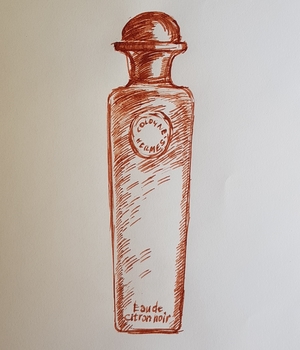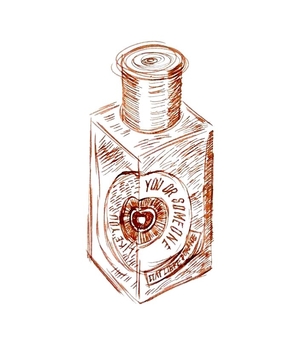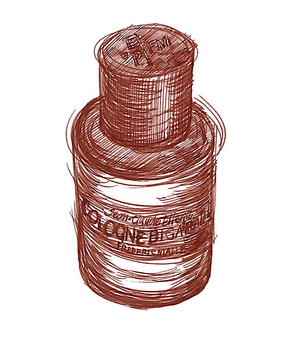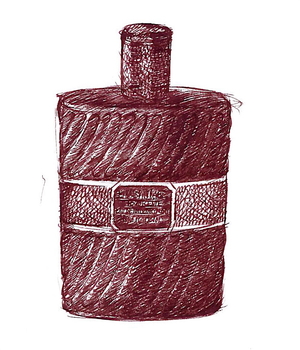Tagged With ‘cologne’
Hermès
Eau de Citron Noir
2 July, 2018
 I’ve always loved eau de cologne. There’s nothing like the exhilarating zing of citrus to start your day, especially in sultry weather. The classic cologne such as 4711 Kölnisch Wasser, with its mix of citrus fruits, lavender, rosemary and neroli oil, is a well-nigh perfect (if all-too-evanescent) formulation, but over the years many perfumers have tried their hand at adding their own individual twist, with greater or lesser success.
I’ve always loved eau de cologne. There’s nothing like the exhilarating zing of citrus to start your day, especially in sultry weather. The classic cologne such as 4711 Kölnisch Wasser, with its mix of citrus fruits, lavender, rosemary and neroli oil, is a well-nigh perfect (if all-too-evanescent) formulation, but over the years many perfumers have tried their hand at adding their own individual twist, with greater or lesser success.
At Guerlain, for example, each generation of perfumers has created their own cologne, and the brand’s range of Les Eaux includes some wonderful reinterpretations such as Jacques Guerlain’s Eau de Fleurs de Cédrat from 1920, or current perfumer Thierry Wasser’s delicious Cologne de Parfumeur from 2010, which adds modern musks and a touch of cedar to the formula.
Hermès launched its first eau de cologne in 1979, with Françoise Caron’s superb Eau de Cologne d’Hermès, which was renamed Eau d’Orange Verte in 1997. For me it’s up there with Dior’s Eau Sauvage and Guerlain’s Vetiver as one of the greatest men’s perfumes around, and I’d expect that it remains their best-selling cologne. In 2009, though, Jean-Claude Ellena started expanding the range, with Eau de Gentiane Blanche and Eau de Pamplemousse Rose, followed in 2013 by Eau de Narcisse Bleue and Eau de Mandarine Ambrée.
Hermès released two more colognes in 2016, marking the handover between Jean-Claude Ellena and his successor as in-house perfumer, Christine Nagel. Ellena’s Eau de Neroli Dorée is a superb celebration of the scent of orange blossom, while Nagel’s Eau de Rhubarbe Ecarlate is fruity and great fun.
Her latest addition to the range is Eau de Citron Noir, which takes lime rather than lemon as its starting point. And not just any lime: the black lime of its name refers to the charcoal-black sun-dried limes you can buy in Oman, where they’re ground up and used as a spice. Nagel credits my fellow perfume blogger Persolaise for introducing her to this ingredient, which shows how important good blogs have become for the industry itself. Black limes give an earthy, rather sour taste to food, and lack the sweetness of fresh limes – but they also have a touch of smokiness, which Nagel has tried to recapture in her cologne.
As a fan of colognes in general and lime in particular, Citron Noir should be right up my street. And it is – at least to start with. As with most colognes, its initial, zesty burst of citrus quickly fades away, to be followed by Nagel’s recreation of the unusual fresh-but-smoky scent of black lime, which still (to me at least) has a bit of fruitiness about it. Unfortunately that’s where I get off, if I can put it that way: on my skin the fruitiness seems to turn slightly sour after a while, and that’s not what I’m looking for in a cologne. On the other hand it makes a fantastically invigorating shower gel, since its initial lime freshness has no time to disappear.
Etat Libre d’Orange
You Or Someone Like You
25 August, 2017
 Victor Hugo, Tom of Finland, Tilda Swinton and the Marquis de Sade may not, on the face of it, have a great deal in common, but they have all inspired perfumes from the French niche-fragrance brand Etat Libre d’Orange.
Victor Hugo, Tom of Finland, Tilda Swinton and the Marquis de Sade may not, on the face of it, have a great deal in common, but they have all inspired perfumes from the French niche-fragrance brand Etat Libre d’Orange.
You Or Someone Like You is a collaboration with American perfume critic Chandler Burr, inspired by (and named after) his first novel, a comedy of manners set in Los Angeles, which I’d highly recommend. Though Burr points out that his perfume is not intended as an ‘olfactory landscape painting’, the heroine of his book is a keen gardener, and the scent he’s created with perfumer Caroline Sabas is as fresh as a spring morning in Beverly Hills.
Zingy citrus, rose, sharp grass and delicious hit of spearmint make for an addictively refreshing summer cologne – so addictive, in fact, that my bottle is already half empty.
Frederic Malle
Cologne Bigarade
10 January, 2015
 Every morning for my breakfast I have tea, toast and home-made marmalade. It’s one of my favourite things, and I love the bittersweet smell of Seville oranges, which only appear in the shops for a couple of weeks around this time of the year.
Every morning for my breakfast I have tea, toast and home-made marmalade. It’s one of my favourite things, and I love the bittersweet smell of Seville oranges, which only appear in the shops for a couple of weeks around this time of the year.
In fact as I sit here writing this post in January, Roy is busy cooking marmalade next door, and the powerful odour of bitter orange (known as bigarade in French) is suffusing the house from kitchen to attic.
So it could hardly be a better time to review Cologne Bigarade, created by the perfumer Jean-Claude Ellena for the French fragrance curator and marketeer, Frédéric Malle (nephew of the film director Louis Malle). Launched in 2001, it was one of the first of the Editions de Parfums Frédéric Malle, and to my mind it’s one of the most immediately appealing and easy to enjoy.
On first – I was going to say ‘glance’, but I suppose I should say ‘spritz’, it smells like a simple but high-quality natural scent, with the exact mix of sweet green freshness and slight bitterness that you get from orange peel and its bitter pith.
You could, I guess, just bottle Seville-orange extract and have done with it – and apparently Jean-Claude Ellena did commission a special new essence for this scent, obtained by molecular extraction. But like all good perfumes Bigarade Cologne is ultimately a clever recreation of what seems, on the surface, like a simple natural scent, using a careful balance of other ingredients to enhance and support the main ingredient.
In this case, Ellena has added a bit of hay and grass – or rather their synthesised essences – which makes the orange even fresher somehow, then subtly underpinned it with a little cedar-wood and rose, adding extra depth and staying-power. You could even say that these extra ingredients suggest the smell of the leaves and the twigs of orange trees, though perhaps that’s going too far.
(Actually, unless you concentrate very hard you can’t really smell them at all; but then we’re so suggestible when it comes to scents that once someone has told you that a particular ingredient is present, you’re more than likely to ‘smell’ it whether it’s actually there or not.)
To me Cologne Bigarade also has a very slight and not unpleasant sweatiness, which (from a short trip to the kitchen and back) is part of the authentic Seville orange smell. In perfume that faint sweatiness is often derived from cumin, and I wonder if there might be a touch of that classic curry spice here too.
Cologne Bigarade is not, perhaps, the most complex perfume on the market, but like most of Jean-Claude Ellena’s fragrances it’s rather more thoughtful and unusual than the general run. Given that he’s also the in-house perfumer for Hermès, it immediately made me think of Hermès’ classic Eau d’Orange Verte, which is also based on the scent of bitter oranges. Though that perfume was originally created by Françoise Caron in 1979, Ellena developed a new version in 2004 called Concentrée d’Orange Verte.
Eau d’Orange Verte is one of my all-time favourite fragrances, yet comparing them side by side, it smells sharper and fresher, but perhaps also slightly less interesting than Cologne Bigarade, which also seems to have much more staying power (a rare quality in a citrus-based cologne, though you can also find it in the fantastic sherbet-lemon Monsieur Balmain).
All the fragrances in the Editions de Parfums Frédéric Malle are expensive, and Cologne Bigarade is no exception, even if its packaging is extremely smart. The heavy, plain-glass bottle has a chunky black cap and comes in a slide-out, black foam-padded box, which in turn slides out (with some effort) of a scarlet card wrapper. If you have money to burn then there’s an even more expensive version called Bigarade Concentrée, which I’ve smelled as a sample and lasts even longer than Cologne Bigarade. The concentrated version also seems to have less of that faint sweatiness about it, which I suspect many people would prefer; I think I do too.
Either way, a fresh but unusual cologne is a wonderful thing to have, so full marks to Jean-Claude Ellena and Frédéric Malle for giving men something a bit different to wear. In a similar vein, though with a very different smell, is Malle’s Geranium Pour Monsieur, which I hope to be able to review before long; watch this space.
Christian Dior
Eau Sauvage
3 March, 2014
 How did I get this far without reviewing Eau Sauvage? And now that I’ve finally got round to reviewing it, how am I going to do justice to such an iconic perfume? OK, I’ve covered Eau Sauvage Extrême, but that’s a dreary spin-off and bears little relation to the glorious real thing. So, deep breath now, and here we go.
How did I get this far without reviewing Eau Sauvage? And now that I’ve finally got round to reviewing it, how am I going to do justice to such an iconic perfume? OK, I’ve covered Eau Sauvage Extrême, but that’s a dreary spin-off and bears little relation to the glorious real thing. So, deep breath now, and here we go.
Created by the legendary perfumer Edmond Roudnitska, Eau Sauvage was launched in 1966, and it’s deservedly regarded as one of the greatest men’s perfumes of all. Roudnitska’s took the idea of a classic men’s cologne, packing it full of fresh, zingy, clean-smelling bergamot-orange oil from southern Italy, but then he did a brilliant thing, by blending it with an equally strong dose of a recently patented chemical called Hedione.
Hedione smells of jasmine – as well it might, since it was discovered by chemists during the process of deconstructing the molecular bits and bobs that, collectively, create natural jasmine’s heady, narcotic scent. Hedione’s real name is methyl dihydrojasmonate, and it was first isolated in 1958 by Dr Edouard Demole, who worked for the giant Swiss perfume company Firmenich.
Methyl dihydrojasmonate has a light jasmine smell but also something citrusy about it, giving Edmond Roudnitska a jigsaw piece that fitted into both the bergamot orange of a man’s cologne, and also had something – but crucially not too much – of natural jasmine’s sumptuous, powerfully floral scent, which most men would have considered far too feminine to wear.
To this Roudnitska added lavender – another floral scent, though this time one whose herby, faintly sweaty character had made it a long-standing male favourite – as well as a range of other, less pronounced ingredients including oakmoss (originally extracted from a lichen that smells of forests after rain) and patchouli, which in small amounts, I’m guessing, enhances the dandified character of Eau Sauvage without pushing it over into full-on let-it-all-hang-out hippiness.
A great perfume is one thing, and an all-too-rare thing at that, but it’s rarer still for a brilliant perfume to be supported by great marketing and presented in a great bottle. And here Eau Sauvage struck lucky again. Christian Dior died in 1957 of a heart attack, but under Yves Saint Laurent and then Marc Bohan, the company commissioned a series of sexy, tongue-in-cheek yet effortlessly elegant posters from René Gruau, arguably the greatest fashion illustrator of the 20th century. They certainly added to Eau Sauvage’s masculine appeal.
Few of us think a great deal about the bottles that contain the perfume we use, though they do have their collectors (most of whom, oddly, seem to have lost interest in the perfumes they contain). But some bottles repay a second glance, and Eau Sauvage is one of them. It was designed by Pierre Camin, who worked for Baccarat and created many of the bottles for the perfumer François Coty, and its chic silver cap, embossed with a pattern of tiny overlapping scales like a freshly-caught mackerel, is said to have been inspired by the silver thimble that Christian Dior always had to hand. The diagonally ridged sides of the bottle itself, meanwhile, are supposed to resemble the regular pleats of a Dior dress, though that seems a bit of a stretch to me.
I could go on, but in the unlikely event that you’ve never smelled Eau Sauvage, or think of it as a tired old dinosaur, I’d rather you headed out and tried it for yourself. Just be careful, though, as Dior have experimented with different versions over the years, and what’s now called Eau Sauvage Extrême (which you’d think would just be a stronger version, as indeed it used to be) is now a completely different fragrance, pleasant enough in a dull way but far less exciting than the original.
My last words, though, go to Edmond Roudnitska, not only because he was a perfumer of genius, but also because he also had something so important to say about marketing that it should be tattooed on the forehead of every perfume-company PR.
‘The choice of a perfume,’ he said, ‘can only rest on the competence acquired by education of olfactive taste, by intelligent curiosity and by a desire to understand the WHY and the HOW of perfume. Instead, the public [is] given inexactitudes and banalities. The proper role of publicity is to assist in the formation of connoisseurs, who are the only worthwhile propagandists for perfume, and it is up to the perfumers to enlighten, orient and direct the publicity agents.’
Here’s to the day his dream comes true.
The job-interview fragrance
20 July, 2012
I was walking down Shaftesbury Avenue last week when I noticed, just ahead of me, a young woman standing outside the lobby of some fairly swanky offices. As I got closer, she reached into her handbag and produced one of those slimline canisters of scent, which she proceeded to spray all over herself like a crop duster until a cloud of foul-smelling perfume drifted across the entire street.
It was only at this point that it struck me how dressed- and made-up she was, and the thought crossed my mind that she must be going for an interview – in which case pity the poor interviewers. I spent the rest of the morning wondering what effect reeking of bad perfume might have on one’s chances.
If there’s a moral to the story (other than move fast if you ever see anyone getting a scent spray out of their bag), perhaps it’s that perfume, if it doesn’t exactly maketh the man, certainly maketh a bigger impression than one might imagine. I can’t imagine many blokes carry their favourite fragrance around with them, but choosing the right perfume for an important occasion is just as crucial for a man as for a woman. Get it wrong and you could ruin your chances.
Discretion may be the better part of valour, but it’s also a good guide when choosing a perfume for a job interview. The easy way out would be not to wear perfume at all, but wearing a really good but understated classic fragrance does wonders for one’s self-confidence – and can also make a good impression on other people, often without them even knowing why.
As far as fragrances go, it’s hard to beat something that embodies old-fashioned masculinity, such as Guerlain’s Vetiver. For something a bit warmer I’d choose Chanel’s Pour Monsieur, not least because it’s actually quite hard to overdo it. It’s a lovely discreet perfume, but if you’re feeling flush then the same company’s delicious, slightly lavendery Eau de Cologne is even finer – though as someone said to me the other day, ‘It’s a lovely cologne, but if I was going to spend that much money I’d buy something a bit more unusual.’
Fair enough – but surely it’s better to invest in a great fragrance than saving your money and smelling like fabric conditioner? Just remember that poor deluded girl on Shaftesbury Avenue. I wonder if she got the job?